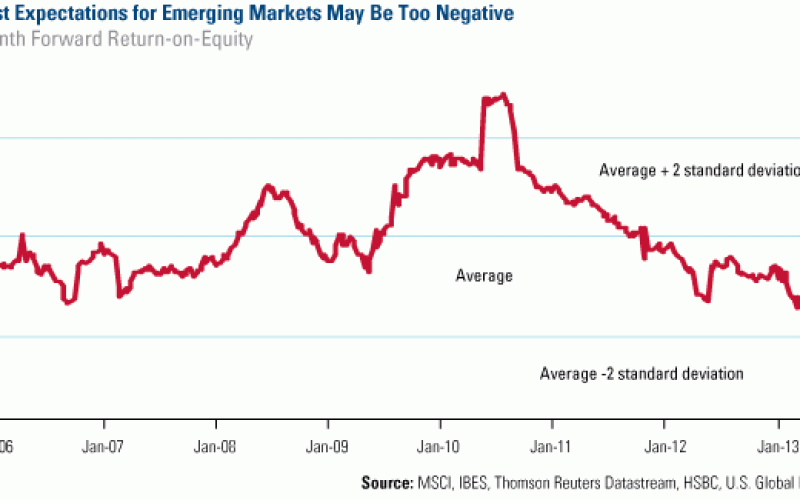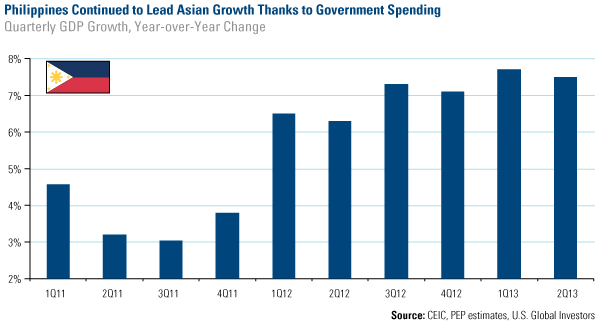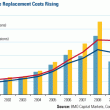Emerging Markets Radar (September 2, 2013)
Strengths
- China has approved a free trade zone for Shanghai, which is a strong indicator that China is serious in pushing economic reform. In addition to the Qianhai free trade zone between Shenzhen and Hong Kong, there might be other free trade zones in major economic areas, such as Tianjin. Business and industrial people are now looking forward to the third plenary meeting of the communist party in November, in which major economic policies are expected to be announced.
- July industrial profits were up 11.6 percent to Rmb419.60 billion, according to the National Statistical Bureau in China.
- China will “gradually” start a new round of investment from second half of more than Rmb1 trillion, Caijing magazine reports, citing unidentified people close to the National Development and Reform Commission (NDRC). The market may have priced in the good news.
- ChiNext, a start-up small cap market in China is the best performing stock market in the world this year, up 66 percent year-to-date. Many believe this is due to the fact that investors are positioned to benefit from the new economy in China. The market’s small cap companies are in areas such as technology, biotech, environmental protection and healthcare, areas poised to benefit from China’s new economy. The NDRC may raise renewable power surcharge, the China Business News reported today.
- Hong Kong July exports growth surprised on the upside, rebounding 10.6 percent year-over-year after two consecutive months of disappointment.
- The Indonesian central bank (BI) raised its reference rate by 50 basis points to 7 percent, higher than the market expectation of 25 basis points, to support Indonesia rupiah. Though the tightening monetary policy is negative to the growth of the economy, the market welcomed the action. BI also raised its deposit rate by 50 basis points to attract local money to stay in rupiah. The government also extended its currency swap agreement with Japan, which provides hard currency to both sides when in need.
- The Philippines saw its second quarter GDP grow 7.5 percent.
Weaknesses
- Four senior executives from PetroChina and Kunlun are being investigated, which shows there are corporate governance issues in China.
- The Thailand manufacturing index was down 4.5 percent in July versus the market estimate of -1.8 percent. Thailand’s July exports fell 1.48 percent versus the market expectation of a 1 percent gain. The value of exports was $19.06 billion which is not enough to reverse the trade deficit, the source of the Thai balt fall. The trade deficit widened to $2.28 billion as imports grew 1.1 percent.
- Philippine June imports fell 4.8 percent year-over-year.
Opportunities
- As shown in the graph above, Philippines second quarter GDP was up 7.5 percent, thanks to robust consumption and government spending. Unlike many Association of Southeast Asian Nations (ASEAN) countries with current account deficits, the Philippines run a current account surplus. The Philippines have just begun their investment and GDP growth cycle. The recent stock market selloff in Manila has nothing to do with Philippine economic fundamentals, but is driven by flow of funds which is usually short lived.
- The rise in U.S. bond yields has been a problem for many emerging markets. However amidst all the current talk of QE tapering and the identity of the next Fed chairman, it has almost gone unnoticed that recent data points from the U.S. economy have been weaker than expected, particularly with regards to the rate sensitive housing market.
- Analyst expectations for emerging markets might have become too negative, according to HSBC, with implied 12-month forward return on equity (ROE) two standard deviations down relative to developed markets.
Threats
- After the recent currency selloff, the economic fundamentals in Indonesia, Malaysia, and Thailand may have weakened to some extent. Economists say those countries need to find a new equilibrium for their overvalued currency so that the economies will find a footing to grow again. In fact, the most important factor behind the currency depreciation was caused by fund outflow, not a misaligned economy. Since the 2008 global financial crisis, over-supplied cheap money had flowed into the emerging markets due their better returns and sound economies. That money is now returning to developed countries after the eurozone sees the light at the end of the tunnel and the U.S. is in a solid recovery. Certainly, the little currency crisis is triggered by Fed tapering talk. Nevertheless, further currency depreciation in ASEAN countries will be the source of volatility for equity and bond markets, which will add further pressure to the liquidity in those countries.
- The outlook for equity markets in countries with current account deficits is almost entirely hostage to the outlook for U.S. yields. Emerging market policy makers have to choose among tighter monetary policy, inflation, or capital controls – all of which are negative for equity markets.

















